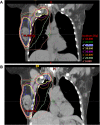Dose reduction to organs at risk with deep-inspiration breath-hold during right breast radiotherapy: a treatment planning study
- PMID: 31822293
- PMCID: PMC6905024
- DOI: 10.1186/s13014-019-1430-x
Dose reduction to organs at risk with deep-inspiration breath-hold during right breast radiotherapy: a treatment planning study
Abstract
Background: The addition of regional nodal radiation (RNI) to whole breast irradiation for high risk breast cancer improves metastases free survival and new data suggests it contributes additional benefit to overall survival. Deep inspiration breath hold (DIBH) has been shown to reduce cardiac and pulmonary dose in the context of left-sided disease treated with or without RNI, yet few studies have investigated its utility for right-breast cancer. This study investigates the potential advantages of DIBH in local and locoregional radiotherapy for right-sided breast cancer.
Methods: Free-breathing (FB) and DIBH computed tomography datasets were obtained from twenty patients who previously underwent radiotherapy for left-sided breast cancer. Ten patients were retrospectively planned for whole right breast only irradiation and ten patients were planned for irradiation to the whole breast plus ipsilateral supra-clavicular (SC) nodes, with and without irradiation of the ipsilateral internal mammary nodes (IMN). Dose-volume metrics for the clinical target volume, lungs, heart, left anterior descending artery, right coronary artery (RCA) and liver were recorded. Differences between FB and DIBH plans were analysed using Wilcoxon signed-rank tests, with P < 0.05 considered statistically significant.
Results: DIBH increased the average total lung volume compared to FB in both breast only and breast plus RNI cohorts (P = 0.001). For the breast only group, there was no significant improvement in any ipsilateral lung dose-volume metric between FB and DIBH. However, for the breast plus RNI group, there was an improvement in ipsilateral lung mean dose (18.9 ± 3.2 Gy to 15.9 ± 2.3 Gy, P = 0.002) and V20Gy (45.3 ± 13.3% to 32.9 ± 9.4%, P = 0.002). In addition, DIBH significantly reduced the maximum dose to the RCA for RNI (11.6 ± 7.2 Gy to 5.6 ± 2.9 Gy, P = 0.03). Significant reductions in the liver V20Gy and maximum dose were observed in all cohorts during DIBH compared to FB.
Conclusions: DIBH is a promising approach for right-breast radiotherapy with considerable sparing of normal tissue, particularly when the ipsilateral IMNs are also irradiated.
Keywords: Breast cancer; Deep inspiration breath-hold; IMRT; Liver; Lung; Regional nodal irradiation; Treatment planning.
Conflict of interest statement
The authors declare that they have no competing interests.
Figures




References
-
- Swanson T, Grills IS, Ye H, Entwistle A, Teahan M, Letts N, et al. Six-year experience routinely using moderate deep inspiration breath-hold for the reduction of cardiac dose in left-sided breast irradiation for patients with early-stage or locally advanced breast cancer. Am J Clin Oncol. 2013;36:24–30. doi: 10.1097/COC.0b013e31823fe481. - DOI - PMC - PubMed
-
- Hjelstuen MHB, Mjaaland I, Vikström J, Dybvik KI. Radiation during deep inspiration allows loco-regional treatment of left breast and axillary-, supraclavicular- and internal mammary lymph nodes without compromising target coverage or dose restrictions to organs at risk. Acta Oncol. 2012;51:333–344. doi: 10.3109/0284186X.2011.618510. - DOI - PubMed
MeSH terms
LinkOut - more resources
Full Text Sources

